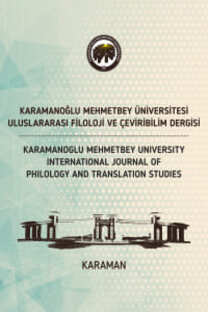THE IMAGES OF DESIRE IN THE 1960S, AND EARLY 1970S TURKISH LOVE FILMS: THE EXAMPLE OF ÖMER LÜTFİ AKAD
Turkish Cinema, Ömer Lütfi Akad, Love Films, Desire
THE IMAGES OF DESIRE IN THE 1960S, AND EARLY 1970S TURKISH LOVE FILMS: THE EXAMPLE OF ÖMER LÜTFİ AKAD
Turkish Cinema, Ömer Lütfi Akad, Love Films, Desire,
___
- Akad, Ö. L. (1959). Yalnızlar Rıhtımı. Türkiye: İpek FilmAkad, Ö. L. (1968a). Vesikalı Yarim. Türkiye: Şeref Film.Akad, Ö. L. (1968b). Kader Böyle İstedi. Türkiye: Şeref Film.Akad, Ö. L. (1969). Seninle Ölmek İstiyorum. Türkiye: Şeref Film.Akad, Ö. L. (1971). Vahşi Çiçek. Türkiye: Erman Film.Akad, Ö. L. (1974). Esir Hayat. Türkiye: Erman Film. Aksoy, O. (1965). Hıçkırık. Türkiye: Erman Film. Badiou, A. (2012). In Praise of Love. London: Serpents Tail.Bauman, Z. (1989). Liquid Love: On the Frailty of Human Bonds. Cambridge: Polity Press.Best, S. & Kellner, D. (1991). Postmodern Theory: Critical Interrogations. Hampshire: MacmillanBourdieu, Pierre. (1993). The Field of Cultural Production. New York: Columbia University Press.Butler, J. (1987). Subjects of Desire. New York: Columbia University Press.Butler, J. (1997). The Psychic Life of Power. California: Stanford University Press.Certeau, M. (1988). The Practice of Everyday Life. Berkeley, Los Angeles: University of California Press.Deleuze, G. (1986). Cinema 1: The Movement Image. Minneapolis: University of Minnesota Press.Deleuze, G. (1989). Cinema 2: The Time Image. Minneapolis: University of Minnesota Press.Deleuze, G. & Guattari, F. (1994). What Is Philosophy?. New York: Columbia University Press.Deleuze, G. & Guattari, F.. (2000). Anti Oedipus: Capitalism and Schizophrenia. Minneapolis: University of Minnesota Press.Eğilmez, E. (1971). Son Hıçkırık. Türkiye: Arzu Film.Erksan, M. (1967). Ayrılsak da Beraberiz. Türkiye: Sine Film.Erksan, M. (1970). Sevenler Ölmez. Türkiye: Akün Film. Freud, S. (2001).The Freud Reader. New York: W. W. Norton & Company.Fromm, E. (2000). The Art of Loving. New York: Continuum.Goodchild, P. (1989). Deleuze and Guattari: An Introduction to the Politics of Desire. London: Sage.Irigaray, L. (1993). An Ethics of Sexual Difference. New York: Cornell University Press.Lacan, J.. (1991).The Seminar of Jacques Lacan: Freud’s Paper on Technique (163-202). New York, London: W. W. Norton Company.Lacan, J. (1997). The Seminar of Jacques Lacan: The Ethics of Psychoanalysis. New York, London: W. W. Norton Company.Lacan, J. (1997). The Seminar of Jacques Lacan: On Feminine Sexuality, The Limits of Love and Knowledge. New York, London: W. W. Norton Company.Levinas, E. (1979). Totality and Infinity. Boston, London: Martinus Nijhoff Publishers. Levinas, E. (1998). Entre Nous: On Thinking-of-the-Other. New York: Columbia University Press.Levinas, E. (1994). Otherwise Than Being or Beyond Essence. Dordtrecht: Kluwer.Nizami. (1965). Leyla ile Mecnun. İstanbul: Milli Eğitim Basımevi.Plato. (1989). The Symposium. Cambridge: Cambridge University Press.Edinburgh: Edinburgh University Press.Refiğ, H. (1965a). Canım Sana Feda. Türkiye: Uğur Film. Refiğ, H. (1965b). Kırık Hayatlar. Türkiye: Uğur Film.Refiğ, H. (1972). Aşk Fırtınası. Türkiye: Er Film.Reich, W. (1970). The Mass Psychology of Fascism. New York: Straus & Giroux.Reich, W. (1974). The Sexual Revolution. New York: Straus & Giroux.Ross, Alison. (2005). Desire. Parr, A. (Ed.) , The Deleuze Dictionary içinde (pp. 63-64). Şeyh Galip. (2010). Hüsn Ü Aşk. İstanbul: İş Bankası Yayınları.Yücel, H. A. (2006). Kerem ile Aslı. İstanbul: İş Bankası Yayınları.Zizek, S. (1991). Looking Awry. Cambridge: The MIT Press.Zizek, S. (1999). The Zizek Reader. Oxford, Malden: Blackwell Publishers.
- Yayın Aralığı: Yılda 2 Sayı
- Başlangıç: 2018
- Yayıncı: Karamanoğlu Mehmetbey Üniversitesi
“DUHA KOCA OĞLU DELİ DUMRUL HİKÂYESİ”NDE YAPI
AB KARAR ALMA MEKANİZMALARINDA KIBRIS SORUNU ve SÜRECİN SONU ANNAN BELGESİ (1990-2004)
SAĞLIK MESLEK YÜKSEKOKULU ÖĞRENCİLERİNİN EMPATİK VE PROBLEM ÇÖZME BECERİLERİNİN İNCELENMESİ
Sümeyra Arzu ORAL PAKSOY, Belgin LİMAN
ERKEN OSMANLI DÖNEMİ’NDE KADIN BÂNÎLERİN BURSA’DAKİ İMAR FAALİYETLERİNE KATKILARI
I. Karaman Uluslararası Dil ve Edebiyat Kongresi (07-09 Kasım 2018)
UNE ETUDE SUR LES IDEES SOCIALES, POLITIQUES ET PHILOSOPHIQUES DE BAHA TEVFIK
KAĞIZMANLI RECEP HIFZI’NIN ŞİİRLERİNDE TABİAT ve MEKÂNA DÖNÜŞ
